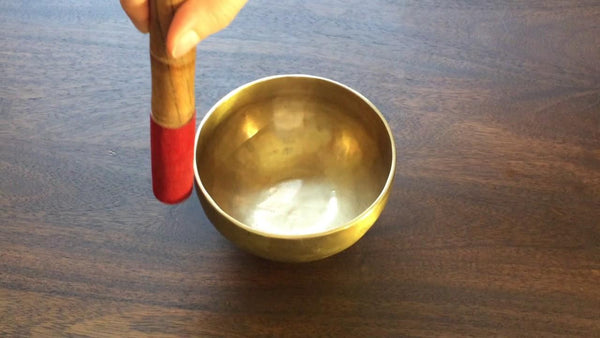If you are new to singing bowls, then you have come to the right place! In this post, we offer the complete guide to singing bowls for beginners. Read on to learn everything you need to know about singing bowls, including how to use them, their history, how they work, their beneficial health effects, and which singing bowls are best for beginners. Let's get started!
Introduction
Chances are that you are already familiar with singing bowls. Perhaps you’ve heard them in yoga classes or in recordings of Buddhist chants and prayers. For those interested in learning more about singing bowls, we have created this ultimate guide for singing bowl beginners. From their history, to their scientific properties, to their powerful healing effects, there is a lot to learn when it comes to Tibetan singing bowls.
In this article we discuss the following:
- What are singing bowls?
- History of singing bowls
- Singing bowls today
- How do singing bowls work?
- How do singing bowls work on our minds and bodies?
- What are the benefits of using singing bowls?
- How do you play singing bowls?
- My singing bowl sounds like this…what should I do?
- What are the best singing bowls for beginners?
- What do beginners absolutely need to know about singing bowls?
What Are Singing Bowls?

First, let’s briefly introduce singing bowls. Singing bowls, also called Tibetan or Himalayan singing bowls, are ancient bowls that produce sound and vibration when played with a mallet or striker. These ancient, multi-harmonic instruments are often linked with Buddhism or other spiritual practices due to their use within meditation practices. Used by monks for thousands of years, singing bowls are now more popular than ever! They are used in everyday meditation, yoga classes, sound therapy, classrooms, hospitals, and more.
These versatile, healing bowls are generally made from an alloy of various metals. Five to seven different metals can be found in a single singing bowl. Singing bowls also come in a variety of sizes, shapes, and styles. Different singing bowls can also have different tones and pitches, and even correlate with specific chakras. When first learning about singing bowls, this may seem like an overload of information. However, learning how to play a singing bowl and incorporating it into your life can be very easy!
History of Singing Bowls
Most original singing bowls come from Buddhist areas such as Tibet, Nepal, and India.
Much of the history of singing bowls remains unknown or unclear due to the Chinese invasion of Tibet in the 1950s. However, oral traditions date singing bowls to the time of the historical Buddha Shayamuni (560 – 480 BCE). Some singing bowls during this time were used for strictly religious purposes within monasteries and temples, such as leading chants or prayers, guiding meditation, or acting as an offering or begging bowl.
Other times, larger bowls were used for grain storage and smaller bowls used to eat from. As the use of singing bowls spread throughout Asia to places like Japan, Korea, China, and Mongolia, their uses expanded as well. For example, Japanese and Vietnamese Buddhists have traditionally used singing bowls to perform funeral rites and to worship their ancestors.
Singing Bowls Today
For hundreds of years, however, what has remained constant is the calming, meditative state singing bowls can create. Singing bowls are useful to Buddhist practitioners and anyone else who is wanting to experience a greater amount of peace and intuition in their daily lives through meditation.Today, singing bowls are found far outside the temples and monasteries of the Himalayan mountains. They are used as tools for meditation or alternative treatment for various illnesses like chronic pain or depression, just to name a few!
Frequently, singing bowls are associated with sound therapy and sound baths or massages. For human beings, sound is a vehicle which can help us arrive to a healthier state of being, both physically and mentally. It also allows us to explore and express the feelings we keep inside of us. For this reason, singing bowls are becoming increasingly popular to treat anxiety disorders, depression, and even post-traumatic stress disorder. The vibrations work throughout our bodies massaging, cleansing, and purifying, while the calm meditative state allows individuals to search within and find what ails them.
 Photo Credit: LoveToKnow
Photo Credit: LoveToKnowWhen researching the benefits of using a singing bowl, you are likely to find it linked with cancer treatment. While the use of singing bowls is not a scientifically-backed treatment for diseases such as cancer, they have been noted to greatly improve the symptoms of the illness and treatment for cancer patients who have used Tibetan singing bowls as a part of their healing process. In a case such as this, singing bowls are not intended to heal the body of the cancerous cells but rather provide relief and balance to other parts of the mind and body. Using a singing bowl in this way is similar to drinking fluids and resting when sick—it does not cure you of your sickness, but it alleviates the symptoms and helps your recovery along the way.
How Do Singing Bowls Work?
What exactly do singing bowls do and how do they do it? The science behind singing bowls is actually quite simple! In fact, this ancient instrument can best be compared to playing wine glasses filled with water. Singing bowls “sing” by creating vibrations. They are played with mallets or strikers. When a mallet or striker makes contact with the side of the singing bowl, friction occurs and vibrations are created. These vibrations are heard through beautiful sounds that are felt within our bodies and energy fields. Changing the speed and pressure of the mallet or striker can then change the sounds that are created. Sticking to the same pressure and speed leads to resonance, which is the note that we can hear even after the player moves the mallet away from the singing bowl.
How Do Singing Bowls Work on Our Minds and Bodies?
Singing bowls can have very powerful effects on our minds and well-being. Many of those who use singing bowls and believe in their strong, healing and meditative powers say that singing bowls and their notes have the power to influence our brainwave patterns through a process called “acoustic entrainment.” This acoustic entrainment is a feeling of deep relaxation and focus as the vibrations of the bowl move throughout our bodies, restoring balance and peace.
Singing bowls can also be incorporated into chakra healing. Singing bowls are able to open and balance chakras. Some say that different chakras can specifically respond to different frequencies of sound produced by singing bowls. Different bowls can be tuned to different notes. Just like an instrument such as a guitar can have different tunings, so can singing bowls! When it comes to differently toned singing bowls, some have found that specific tunings impact specific chakras. The following tunings are matched with the following seven chakras:
- Root Chakra: C Note
- Sacral Chakra: D Note
- Solar Plexus Chakra: E Note
- Heart Chakra: F Note
- Throat Chakra: G Note
- Third Eye Chakra: A Note
- Crown Chakra: B Note

Source: Jevon Dängeli
What are the Benefits of Singing Bowls?
There are numerous benefits to playing a singing bowl. Singing bowls have the power to heal sickness, improve overall well-being, or target specific issues one might be experiencing. Here’s a general list of benefits that can be realized through playing a singing bowl.
- Chakra cleansing
- Promote relaxation
- Soothe illnesses and pain
- Aid in reducing the pain caused by cancer treatment
- Reduce stress and anxiety
- Improve blood pressure and flow
- Tool for anger management
- Create peace
- Improve the immune system
- Boost overall well-being and contentment
- Remove negative energy from your home
- Enhance sleep
- Cleanse and charge crystals
- Heighten clarity of mind and intuition
How Do You Play Singing Bowls?
Playing a singing bowl can cause a rush of varying emotions from feeling invigorated to relaxed. But how can you achieve such blissful and calm moods? Luckily, there are several different ways to play a singing bowl, ranging from very beginner to advanced.
As this is a guide for beginners, we’ll focus on the two most popular ways to play a singing bowl: striking and rimming. Other popular techniques, such as the “Wah Wah” Method or filling the singing bowl with water may be difficult for some people when they first start experimenting with singing bowls. Therefore, we suggest beginning with striking and rimming. In order to use either method, you will need a singing bowl, of course, but also a mallet or striker and an appropriate resting spot for your singing bowl.

Photo Credit: Refined Massage Therapy
The rimming technique, which may be a bit more difficult than the striking method, involves what’s usually a leather-wrapped or wooden mallet. When it comes to how to hold the mallet, you should find the way that feels most comfortable to you. However, most people find it best to hold the mallet at an angle as though writing with a pen, while others grip the mallet with all five fingers and act as if they are stirring something in a pot. This is the technique that really lets your singing bowl sing! When starting out, be mindful of your patience. You many need to circle the bowl numerous times before it starts producing sounds but this is okay—it will all improve with practice! Apply even pressure and move the mallet clockwise around the rim of the bowl. Pace yourself and don’t rub too quickly. Allow the sound to build over time instead of all at once. This should create a beautiful, peaceful sound to meditate to.

As with any new skill, you cannot become a master overnight but remember to keep it up. Frequently playing your singing bowl will not only improve your overall well-being, but also improve the singing bowl’s ability to sing. As you play your singing bowl more, the singing bowl will create grooves in the side of the mallet. These grooves actually help the mallet get a better grip on the singing bowl’s rim, which will make it easier to play. Additionally, as bowls age, their tones mature and become mellower and deeper.
My Singing Bowl Sounds Like This…What Should I Do?
As a beginner, it is likely you will run into issues playing your singing bowl. We’re here to help and guide you!
My Singing Bowl is “Chattering”
A “chattering” or rattling singing bowl is one that sounds high-pitched with uneven, unequal sounds. If your bowl is chattering, you will know—it’s not very pleasant or relaxing to hear! The chattering sound is caused by uneven or not enough pressure. To stop the stick from bouncing off the bowl, slow down and apply more even pressure.
My Singing Bowl is Too High Pitched
If you feel that your singing bowl is too high pitched, it could be one of two things. The first cause might be that you purchased a bowl with high-pitched tones. While smaller singing bowls are likely to be higher-pitched (which does not have to be a bad thing, as higher pitched bowls are often used in driving out illnesses or pain), it is possible you prefer a lower pitched bowl. In this case, we suggest looking for a larger or medium-sized bowl, which will have much lower notes.
The second reason why your singing bowl might be too high pitched is that you are using the wrong mallet. A wooden mallet rimming or striking a singing bowl will give off higher pitches which may be unpleasant for some. If this is the case, try rimming your singing bowl with a leather-wrapped mallet or striking it with a wool-padded striker.
My Singing Bowl Sounds Fine but Sometimes the Sound Feels Overwhelming
It is possible to be overly affected by your Tibetan singing bowl. As a beginner, this will likely be your first time being around and playing a singing bowl. If you find that the singing bowl negatively affects you, try cutting down the time spent playing the playing to a maximum of five minutes a day. It might also be useful to practice in the evening before bed so that you can process the vibrations and energy emitted by the bowl while sleeping.
Another reason why your singing bowl might feel overwhelming is the bowl’s loudness. Crystal singing bowls, for example, are known for their incredibly loud tones. If you find that your singing bowl is too loud, apply lighter, gentler pressure and slow down the rotation.
What Are the Best Singing Bowls for Beginners?
Just as singing bowls vary in size, shape, and style, they also vary in price. As a singing bowl beginner, you may not be interested in spending hundreds, perhaps, thousands of dollars on a genuine, antique bowl. While antique bowls are super high quality and special bowls to play, a beginner may have better luck learning on a small to medium sized machine-made bowl.
Because machine-made bowls are often smoother than their hand-beaten counterparts, you might find that they are easier to play and give off a cleaner, steadier, and more even note when struck. Their smoother surfaces also make it easier to make them sing. A quality, machine-made bowl is a perfect, affordable singing bowl for many beginners!
In particular, you should consider purchasing a singing bowl from Shanti Bowl, which was founded in 2015 to spread awareness of the beauty and health benefits of singing bowls. These bowls, which are of the highest quality, are intentionally priced well below their market value in order to ensure they are accessible to the most people possible. In addition, Shanti Bowl donates significant proceeds to non-profit organizations that work to provide meditation and mindfulness practices to at-risk communities.
Check out our complete guide about how to choose a singing bowl.
What Do Beginners Absolutely Need to Know About Singing Bowls?
While this post has been comprehensive and thorough for those newly acquainted with singing bowls, we want to end on some pretty basic pointers that you should definitely take away from this post. These are things that every beginner needs to know!
- Practice! Playing the singing bowl is like learning any other skill: practice makes perfect. You have to be consistent in playing your singing bowl and avoid getting discouraged when you struggle.
- Related to Number 1, Number 2 is a reminder to be patient, both with yourself and your bowl. Playing a singing bowl is supposed to be a relaxing experience. If you are tense or trying too hard, it takes the enjoyment out of the tranquil sounds the singing bowl can produce.
- It’s important to have the correct accessories to play your singing bowl. The wrong mallet can hinder the singing bowl from playing to its best ability. A larger bowl will require a mallet with a greater mass and surface area while a smaller bowl will require the opposite.
- Find your bowl’s “sweet spot.” A singing bowl sweet spot is the place where the vibration is most stable and smooth, free from chatter or interference. The sweet spot will also sound its harmonic tones at an equal volume. Finding your bowl’s sweet spot is a combination of effort, patience, speed, pressure, and angle.
- Lastly, it is necessary to experiment and find the method or mallets that work best for you and your needs. The best way to get to know your singing bowl is to listen to it and experiment with drawing out its many different tones and harmonics.
We hope this was an illuminating guide on the wonders of singing bowls! Anyone can play and enjoy the vibrations and sounds the singing bowl creates. We invite you to get your own Tibetan singing bowl or crystal singing bowl and experience newly found peace and tranquility for a lifetime.
Did You Enjoy This Article?
Thank you for reading! If you enjoyed this article, you might also like the following articles: How to Choose a Singing Bowl: Complete Guide and Singing Bowl Meditation: The Complete Guide


30 comments
Mar 20, 2025 • Posted by Liara
Appreciate the detailed insight. Namaste!
Mar 28, 2023 • Posted by Amreeta
Very interesting.
Well detailed and explained.
Thank you
Mar 14, 2023 • Posted by Jill
Very interesting and informative . Thankyou for your time in writing this article.
Feb 13, 2023 • Posted by Shar
Wanting to learn more on singing bowls and meditation for my health
Dec 05, 2022 • Posted by Eileen Tottman
This article is great 👍 thank you as i am presenting a short workshop fir relaxation next year 2023 to go along with back and hand massage session 😀 in a ladies group.
Any further information is greatly accepted.
Sep 20, 2022 • Posted by Demetrio
Thank You! A very nice and helpful article.
Oct 05, 2021 • Posted by Shanti Bowl
Hi Jessica, thanks so much for your comment! So glad you enjoyed our article! :)
Oct 05, 2021 • Posted by Jessica
YES & YES:) thank you for putting the article together, very helpful. Jessica
Aug 30, 2021 • Posted by Shanti Bowl
Hi Amy, thanks so much for your message! So glad you found our article helpful!
Aug 30, 2021 • Posted by Amy Sales
This was super informative and helpful. Thank you!
Leave a comment